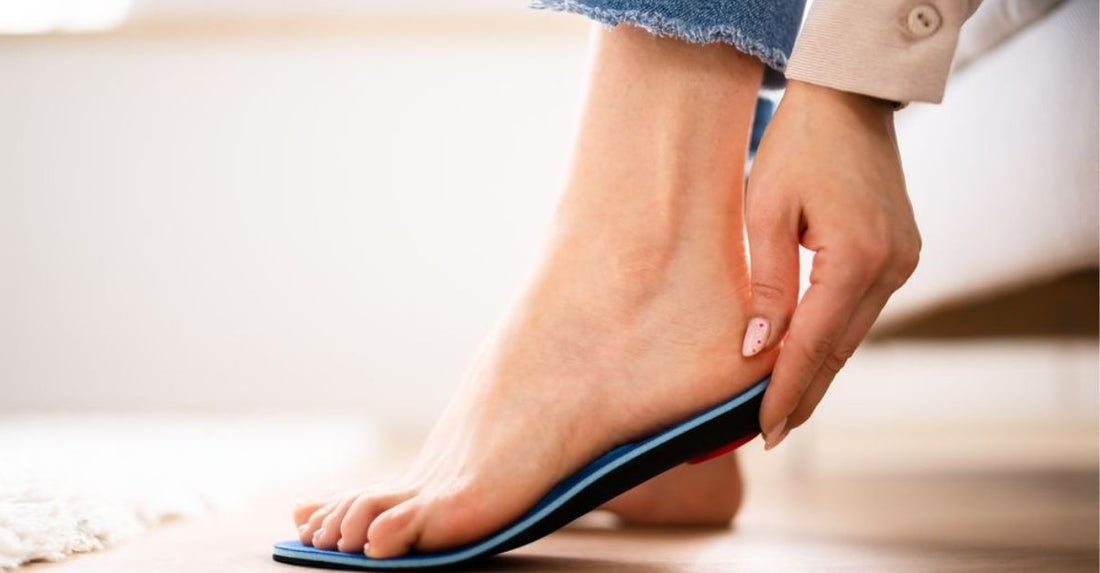
5 Ways to Know it's Time to Replace Your Orthotics
Share
Orthotics are essential tools for many people, providing the support and alignment needed to relieve foot pain and improve overall posture. However, orthotics don't last forever like any product that experiences regular wear. Using worn-out orthotics can do more harm than good, potentially leading to discomfort and new health issues.
Understanding when to replace your orthotic insoles is vital for maintaining their effectiveness. This guide highlights five key signs indicating it’s time for a new pair, ensuring your feet stay healthy, comfortable, and well-supported at every step.
1. Visible Wear and Tear
Constant use can cause the materials to break down, leading to cracks, thinning, or deformities in the orthotic structure.
How to Check for Wear and Tear:
- Look for cracks or splits in the shell if the shell is visible.
- Inspect for curling edges or areas where the orthotic no longer fits snugly in your shoe.
Worn-out orthotics can’t provide the necessary support, leading to discomfort and potential foot problems. Regularly inspect your orthotics, especially if you wear them daily or during high-impact activities. If you notice any visible damage, such as a cracked plastic shell, it’s time for a new pair.
2. Increased Foot or Joint Pain
Orthotics are designed to alleviate pain, not cause it. If you start experiencing foot, ankle, knee, or even lower back pain after wearing your orthotics for a while, it may indicate that they are no longer providing adequate support.
Why Pain Occurs with Worn Orthotics:
- The cushioning may have worn down, reducing shock absorption.
- The structural support may have weakened, causing misalignment.
- Your foot condition may have changed, requiring a new type of support.
Ignoring this pain can lead to more severe issues, as your body tries to compensate for the lack of support. If your orthotics are no longer comfortable or are causing pain, it’s time to visit a specialist and consider replacements.
3. Changes in Footwear Fit
Orthotics should fit comfortably in your shoes without causing tightness or shifting. Over time, the materials in orthotics can compress or deform, affecting how they fit in your footwear.
Signs of Poor Fit Due to Worn Orthotics:
- Your shoes feel looser than usual.
- The orthotics move around inside your shoe.
An ill-fitting orthotic compromises support and can lead to new foot problems. If you find yourself adjusting your orthotics frequently or experiencing discomfort, it’s likely time for a new pair.
4. Fading Support and Cushioning
Orthotics are designed to provide both structural support and cushioning. Over time, the materials can lose their resilience, reducing their ability to support your arches or cushion your steps.
How to Test for Cushioning Loss:
- Press on the cushioning areas to see if they feel flat or hard.
- Notice any increased foot fatigue after long periods of standing or walking.
- Pay attention to recurring aches in your feet or joints after wearing your orthotics.
When orthotics lose their cushioning, they can’t absorb shock effectively, putting more strain on your feet and joints. Replacing them ensures you continue to receive the comfort and support you need.
5. Time Since Last Replacement
Even without visible signs of wear, orthotics have a limited lifespan. On average, orthotics last between one to two years, depending on usage, materials, and activity level.
General Guidelines for Replacement:
- Daily wearers: Replace every 6-9 months.
- Athletes or active individuals: Replace every 4-6 months due to higher wear.
- Occasional users: Replace every 9-12 months, depending on condition.
Regular check-ups with a podiatrist can help determine when your orthotics need replacing, even if they appear to be in good condition. Keeping track of when you received your orthotics helps ensure timely replacements and continued foot support.
Bottom Line
Recognizing the signs that your orthotics need replacing ensures you continue to receive proper support, alignment, and comfort. Regularly checking for wear, paying attention to changes in fit and pain levels, and consulting with a specialist help keep your feet healthy and pain-free. Investing in timely orthotic replacements promotes better posture, reduces injury risks, and enhances your quality of life.
Frequently Asked Questions
How often should orthotics be replaced?
Orthotics should generally be replaced every 6-9 months, depending on usage, activity level, and material durability. Athletes may need replacements every 4-6 months due to higher wear.
What happens if I don’t replace my orthotics?
Failing to replace worn orthotics can lead to inadequate support, increased foot pain, misalignment, and potential injuries. Regular replacements ensure optimal foot health and comfort.
Can I extend the life of my orthotics?
Yes, you can extend the life of your orthotics by rotating pairs, using appropriate footwear, and keeping them clean and dry. Regular inspections also help catch early signs of wear.
Do I need a new prescription for orthotic replacement?
It’s advisable to consult a podiatrist when replacing orthotics. Your foot structure or condition may have changed, requiring a new prescription for the best support.
Does insurance cover orthotic replacements?
Many insurance plans cover orthotic replacements when deemed medically necessary. Check with your provider for coverage details and replacement frequency.
